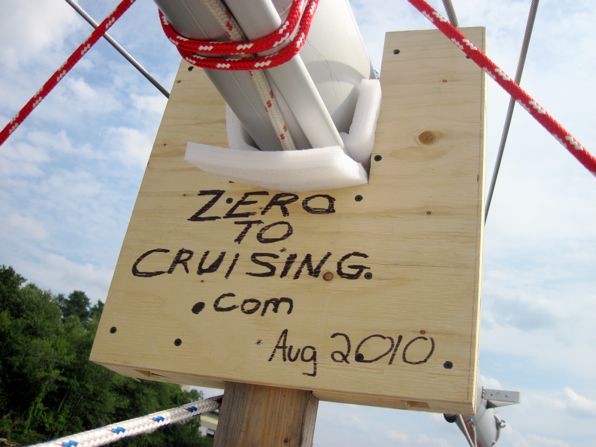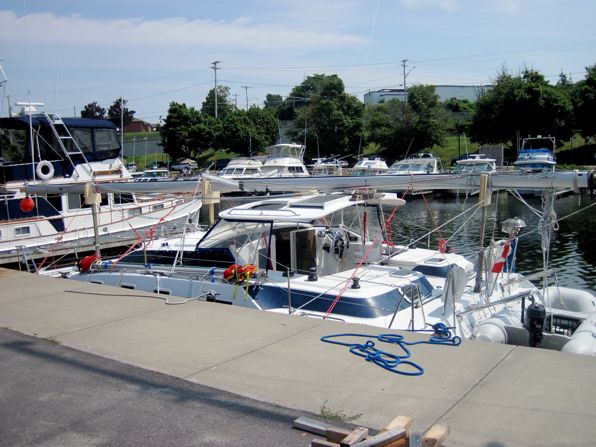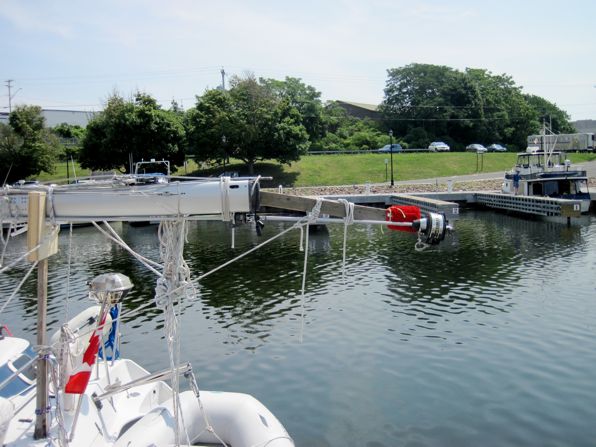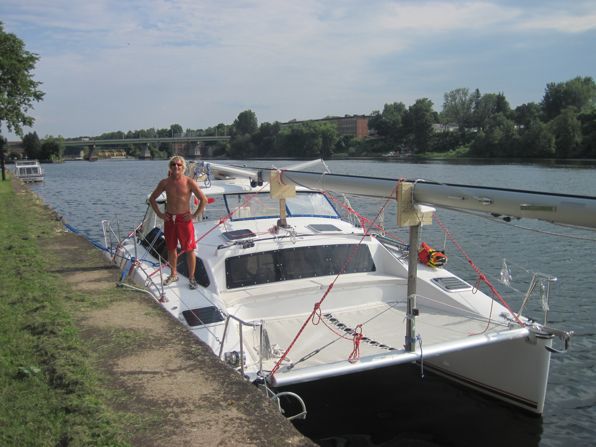We traded in our sail boat for a motor boat!
Yes, it’s true. After removing our mast in Oswego, NY yesterday, prior to beginning our journey south through the NY State canal system, we now have a motor boat!
As I have mentioned here on numerous occasions, how we would safely carry our mast during this part of our journey was a source of great concern for me. After all, dropping the mast in the water, or on deck for that matter, would be a huge problem (read HUGE $$$$). Here is ultimately what we ended up doing, greatly inspired by the catamaran Windsong which spent only a single night at our marina a few weeks ago.
The first decision was where to carry the mast: in the center on top of the bimini or on the side on one of the hulls. Because of our rig, we opted for the center option so that we wouldn’t have to remove the spreaders.
After making this decision, we then constructed “gallows” out of plywood, sandwiching 2x4s together in a shape that would not only hold the mast but also allow a vertical 2×4 “pole” to slide into a slot. We made 3 of these: one for the bow, one for the stern and one for the mast step. The gallows had enough play in them to allow some foam to be inserted to protect the mast (Note: The first attempt at building them did not have enough room for even the mast. We had to trim them in a band saw to add more space).

These gallows only get a 1-way trip on our boat.
We’ll be leaving them wherever we put our mast back up.
Rather than using a sawhorse-type arrangement where additional wood would be used to provide lateral support, we instead used line. Lots of line. Brand new red 3/8″ line as a matter of fact. Just as the guy lines on a tent keep the poles vertical, we used lines to each hull, cinched down with trucker’s hitches to hold the mast stable. In addition to side to side stability, we also needed to ensure that the mast couldn’t move fore and aft. More lines were used for this, much like spring lines on a boat.

You can see the boom, and battens, lashed together on the port hull. We used a couple of red PFDs and a large cockpit cushion for padding. The mast is also resting on a pad on a strong section of the hard bimini.
A chiseled-out 2×4 was fit into the base of the mast to support the roller-furling forestay. All the bits and pieces were lashed together and the end result is pretty stable. Truthfully, that is an understatement. I think it is very stable, although I’ll give you my final verdict after we make it across Lake Oneida (Lake Oneida is known for sometimes being particularly rough)!

That red car-wash mitt fit perfectly on the 2×4. 🙂
Although Bernie, who ran the crane at the Oswego Marina laughed at us, we tied our big orange fender ball to the tip of the mast. We also fit a bright red car-wash glove over the 2×4 in the other end of the mast. The purpose of these items was not to protect the mast but rather to make anyone helping us with lines SEE the mast as it projects out away from the boat. Because it doesn’t have the mass of the boat, I have heard that many people don’t focus on the mast and thus aren’t ready to protect it, or themselves as it moves towards them.

On the wall in Fulton, NY where we stopped for our first night in the canals.
So, that’s it. Fingers are crossed that it stays in place long enough to get us through the canals. If you choose to use a similar method, I hope it works for you too.
The following video has Rebecca narrating our way through one of the locks. These locks are truly amazing!


Truly amazing how the locks work – great video!
Yes, the locks (these ones anyway) are gravity fed. And the clever shape of the doors prevent them from opening until the pressure is equal on both sides (I assume).
Great video!! Please keep them coming. It’s great for anyone who is planning to head south one day. I’ve often seen the fender boards on boats but never knew how they were used. Your on your way and we can share in your adventures!!! The mast looks like it’s not going anywhere. Great job guys.
Miss you guys.
Terry & Anneke
Wish you were here. 🙂
I’m glad the truckers hitch came in handy
Very handy. I need to go and cinch them down a bit more later today.
Just have to tell you that I have been “stalking” your blog for a long time. Went back and read all the posts. I just love it. I am so excited and happy for the both of you. A great adventure!
Fair Winds
Thanks for following along and thanks for posting! Hopefully we’ll have even better things to post about now that we’re on the move.
Since you guys are doing locks, you might be interested in the British narrowboats, who might do 10 locks in a mile or two (and tunnels, and aqueducts – think of a bridge for boats). I’ve been enjoying the action over at http://indigodream.wordpress.com, http://watertigermetalrat.blogspot.com and several others. Locking seems to be a way of life for them.
We’ve done the Hiram Chittenden locks here in Ballard a few times, but mostly try to avoid them if possible.
bob
Truthfully, although the locks are cool enough, I will be infinitely happier once our cat is a “sail” boat once again. Now, if I had one of those boats designed for canals, I’m sure I would enjoy it even more.
Hi and congrats on leaving. That gets you below the 1 in a 100 who actually do it!
I’d never realised that if you are in your part of the world there’s a canal induction, like there is for some boaters heading south from the UK. We didn’t (Biscay instead, RG draws too much water) but lots of people do and it’s a whole adventure of its own. Completely different from sail cruising but really exciting.
All looks excellent. Just don’t actually crack your hull cinching that trucker’s hitch. There’s a lot of power in that knot!
I wonder what the percentage really is?
The trucker’s hitch, initially taught to me by my father-in-law, is definitely a good knot to know.
Ah your cruising day is not complete without going through a few locks!
Funny how things differ depending on the type of boat you have – we are doing a fair bit of cruising on the tidal Thames this summer, which, for us in a flat bottomed shallow drafted narrowboat, is pretty amazing.
Richard
Very cool, Richard. I’m sure that would be awesome.